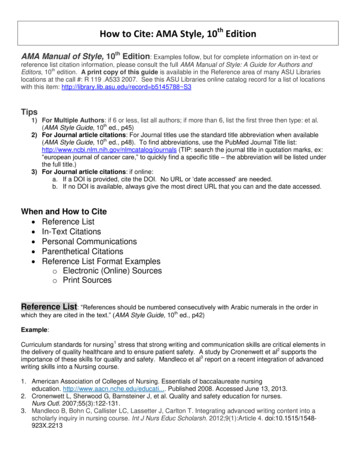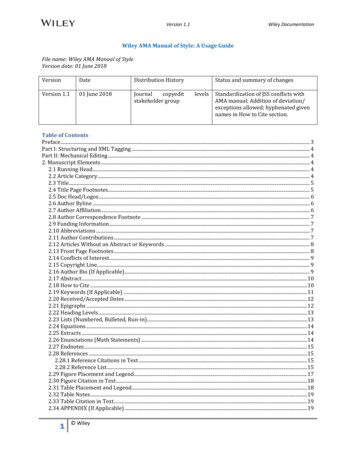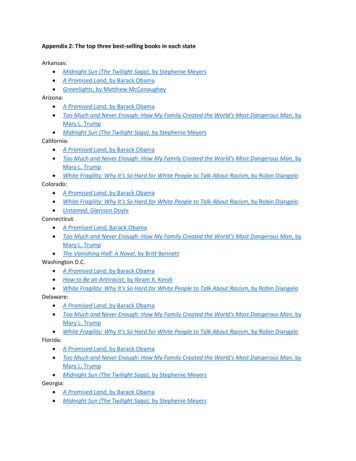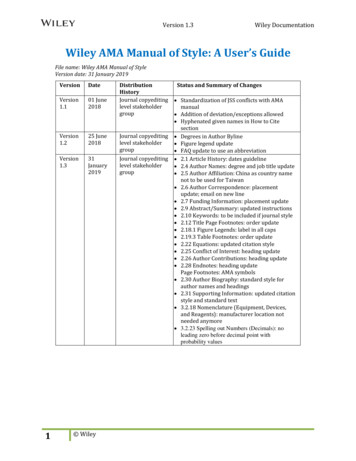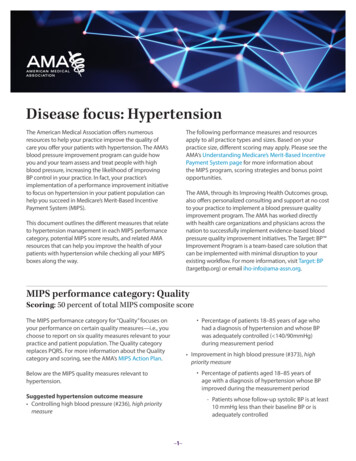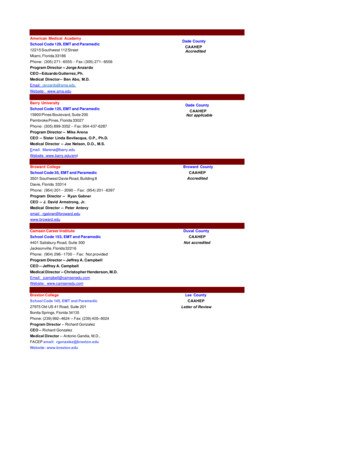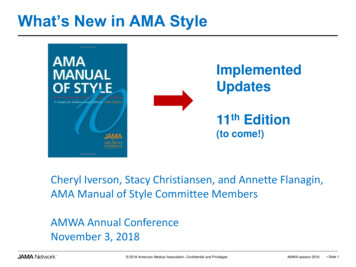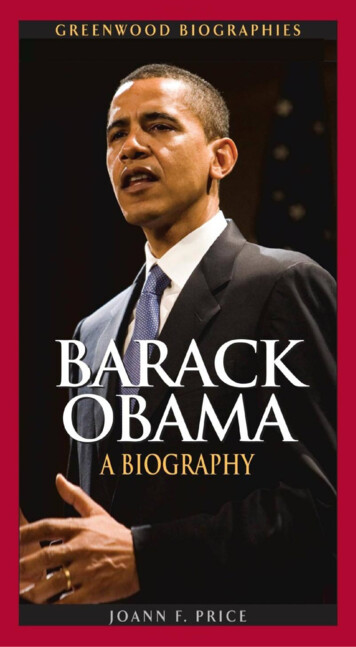
Transcription
Barack Obama
Recent Titles in Greenwood BiographiesSteven Spielberg: A BiographyKathi JacksonMadonna: A BiographyMary CrossJackie Robinson: A BiographyMary Kay LingeBob Marley: A BiographyDavid V. MoskowitzSitting Bull: A BiographyEdward J. RiellyEleanor Roosevelt: A BiographyCynthia M. HarrisJesse Owens: A BiographyJacqueline EdmondsonThe Notorious B.I.G.: A BiographyHolly LangHillary Clinton: A BiographyDena B. Levy and Nicole R. KrassasJohnny Depp: A BiographyMichael BlitzJudy Blume: A BiographyKathleen TracyNelson Mandela: A BiographyPeter LimbLeBron James: A BiographyLew Freedmanii
Barack ObamaA BiographyJoann F. Pricegreenwood biographiesgreenwood pressWestport, Connecticut Londoniii
Library of Congress Cataloging-in-Publication DataPrice, Joann F.Barack Obama : a biography / Joann F. Price.p. cm. — (Greenwood biographies, ISSN 1540–4900)Includes bibliographical references and index.ISBN: 978–0–313–34488–6 (alk. paper) 1. Obama, Barack.2. Presidential candidates—United States—Biography. 3. AfricanAmerican legislators—United States—Biography. 4. Legislators—United States—Biography. 5. United States. Congress. Senate—Biography. 6. United States—Politics and government—2001–7. Illinois—Politics and government—1951– I. Title.E901.1.O23P75 2008328.73092—dc22[B]2008006578British Library Cataloguing in Publication Data is available.Copyright 2008 by Joann F. PriceAll rights reserved. No portion of this book may bereproduced, by any process or technique, without theexpress written consent of the publisher.Library of Congress Catalog Card Number: 2008006578ISBN: 978–0–313–34488–6ISSN: 1540–4900First published in 2008Greenwood Press, 88 Post Road West, Westport, CT 06881An imprint of Greenwood Publishing Group, Inc.www.greenwood.comPrinted in the United States of AmericaThe paper used in this book complies with thePermanent Paper Standard issued by the NationalInformation Standards Organization (Z39.48–1984).10987654321iv
Once again and always, to Bob. Your love and support makeeverything possible.
ContentsSeries Foreword ixIntroduction xiTimeline: Events Significant to the Life of Barack Obama Chapter 1 Family History xiii1Chapter 2 Formative Years in Hawaii and Indonesia 17Chapter 3 College and Community Activism in Chicago 29Chapter 4 A Trip to Kenya and Harvard Law School 41Chapter 5 Teaching Constitutional Law, Marriage,Family, and Illinois State Politics 51Chapter 6 The Senator from the State of Illinois 65Chapter 7 Best-selling Author, Michelle Obama, andAnother Trip to Africa 77Chapter 8 Obamamania, an Exploratory Committee,and the Announcement 85Chapter 9 The Campaign for the Presidency 97Chapter 10 The Campaign Continues 111Epilogue 119Bibliography 133Index 139Photo essay follows page 64vii
Series ForewordIn response to high school and public library needs, Greenwood developed this distinguished series of full-length biographies specifically forstudent use. Prepared by field experts and professionals, these engagingbiographies are tailored for high school students who need challenging yetaccessible biographies. Ideal for secondary school assignments, the length,format, and subject areas are designed to meet educators’ requirementsand students’ interests.Greenwood offers an extensive selection of biographies spanning allcurriculum-related subject areas including social studies, the sciences,literature and the arts, history and politics, as well as popular culture,covering public figures and famous personalities from all time periods andbackgrounds, both historic and contemporary, who have made an impacton American and/or world culture. Greenwood biographies were chosenbased on comprehensive feedback from librarians and educators. Consideration was given to both curriculum relevance and inherent interest.The result is an intriguing mix of the well known and the unexpected, thesaints and sinners from long-ago history and contemporary pop culture.Readers will find a wide array of subject choices from fascinating crimefigures like Al Capone to inspiring pioneers like Margaret Mead, fromthe greatest minds of our time like Stephen Hawking to the most amazingsuccess stories of our day like J. K. Rowling.While the emphasis is on fact, not glorification, the books are meantto be fun to read. Each volume provides in-depth information about thesubject’s life from birth through childhood, the teen years, and adulthood.ix
SERIES FO REWO R DA thorough account relates family background and education, tracespersonal and professional influences, and explores struggles, accomplishments, and contributions. A timeline highlights the most significant lifeevents against a historical perspective. Bibliographies supplement the reference value of each volume.
IntroductionIn no other country on earth is my story even possible.—Barack Obama, July 27, 2004On July 27, 2004, Illinois State Senator Barack Obama delivered the keynote speech at the Democratic National Convention. He said, “Tonight isa particular honor for me because, let’s face it, my presence on this stage ispretty unlikely.” When he finished his speech, the audience that listenedwith rapt attention excitedly waved their arms, hats, and signs, thrilledwith what they had just heard. Afterward, those watching on televisionsaid that they had stood and cheered, many admitting they danced. Somewondered what had just happened. For many Democrats, the speech waselectrifying and inspiring; for them, it was a joyful time. And those fromthe other side of the political aisle who watched and listened had to agree:this fresh face, this politico, unknown to nearly everyone in the country outside of his home state of Illinois, had just delivered a remarkablespeech. Many asked, who is this man and where did he come from? Theyasked why he was selected to deliver such an important speech at theDemocratic National Convention at a time described by many as a verycontentious time in U.S. politics.In the speech that evening—a speech that he wrote himself and delivered without the use of a teleprompter—Barack Obama introducedhimself by first describing his father, born and raised in a small village inKenya, and his paternal grandfather, a cook and domestic servant who,he said, had big dreams for his son. He told the immense crowd that hisfather, through hard work and perseverance, earned a scholarship to studyxi
xiiIntroductionin a magical place called America, which to his Kenyan countrymen was aplace of freedom and opportunity. Barack told the excited crowd that Julyevening that his maternal grandfather worked on oil rigs and farms during the Depression and, just after Pearl Harbor, joined the army, and thathis grandmother, while raising their baby, worked on a bomber assemblyline during the war. He described how his grandparents moved west fromKansas, seeking opportunities, ultimately moving to Hawaii. They too,he said, had big dreams for their daughter. He said his parents met whilestudying at the University of Hawaii and that they shared not only an improbable love, but also an abiding faith in the possibilities of this nation.Barack said that this country’s pride is based on a simple premise, summedup in the Declaration of Independence, as “the true genius of America, afaith in the simple dreams of its people, the insistence on small miracles.”The speech that evening undeniably catapulted this state senator from Illinois onto the national political scene. If Americans hadn’t heard ofhim before, they certainly knew about him now.Barack Obama says that his story could take place only in America. Heoften adds that, like his parents and grandparents, anyone can achievesuccess through hard work and scholarship. His story is filled with goodfortune, hard work, and a very good education. It is also a story of diversity of heritage that he is proud of—that is, after he came to understandand accept it.In the United States, many political leaders throughout history havecome from powerful families. For Barack Obama, this is far from the truth.His upbringing was in humble circumstances, and, while he doesn’t fitany typical political mold, he is already considered by many to be one ofthe most dynamic figures in U.S. politics. His oratory skills, direct style,and ability to communicate are often compared with those of AbrahamLincoln, John F. Kennedy, and Robert Kennedy.Barack Obama is truly a rising political star in the United States. Withan African first name that means “blessed,” his name is often mispronounced and sometimes ridiculed. However seemingly blessed, he statesthat he is meant to serve and to lead, and perhaps someday be presidentof the United States.
Timeline: EventsSignificant to theLife of Barack Obama1863 President Abraham Lincoln signs the EmancipationProclamation. Barack often associates himself with President Lincoln. When he announced his candidacy for the2008 election, he spoke in front of the Old State CapitolBuilding in Springfield, Illinois, where Lincoln famouslydeclared, “A house divided against itself cannot stand.”1895 Barack’s paternal grandfather, Hussein Onyango Obama, isborn in Kenya.1920 August 18—The 19th Amendment to the U.S. Constitution is ratified, giving women the right to vote.1929 January 15—Reverend Martin Luther King Jr. is born.1936 Barack’s father, Barack Obama Sr., is born in Kenya.1940–1945 During World War II, Barack’s paternal grandfather, Hussein Onyango Obama, serves as a cook to a British captain. Stanley “Gramps” Dunham, Barack’s maternal grandfather, and Madelyn “Toots” Dunham elope just prior tothe attacks at Pearl Harbor on December 7, 1941. Stanleyenlists in the army soon after the attacks, and Madelynworks on a bomber plane assembly line. Barack’s mother, Stanley Ann Dunham (known as Ann),is born in 1942, while her father, Stanley, is posted at anarmy base.1946 August 19—President William Clinton is born.1947 October 26—Senator Hillary Clinton is born.1953 June 10—Senator John Edwards is born.xiii
xivB arackTimelineO bama1959 Barack’s grandparents, Stanley “Gramps” and Madelyn“Toots” Dunham, and their daughter, Stanley Ann Dunham, Barack’s mother, move to Hawaii. Ann Dunham, after being accepted by the University ofChicago, decides to enroll at the University of Hawaii.She is 18 years old. Barack Obama Sr. leaves Kenya to attend the University of Hawaii at the age of 23. Ann Dunham and Barack Obama Sr. meet as students atthe University of Hawaii. They are soon married.1960 September 26—The first Nixon-Kennedy debate is televised.1961 May 4—Civil rights activists known as the Freedom Ridersride interstate busses into the segregated South; they aresubsequently arrested for trespassing and unlawful assembly and are met with fire bombs and riots. Many suffer atthe hands of racists. August 4—Barack Hussein Obama is born in Hawaii.1963 Barack Obama Sr. accepts a scholarship to attend Harvard University. Ann and Barack stay in Hawaii. Barack Obama Sr. leaves the United States to return toKenya. He and Ann Dunham Obama are divorced. August 28—Reverend Martin Luther King Jr. delivers his“I have a dream” speech in Washington, DC.November 22—President John F. Kennedy is assassinated.1964 January 17—Michelle Robinson (Obama) is born. July 2—President Johnson signs the Civil Rights Act intolaw. October 14—Reverend Martin Luther King Jr. wins theNobel Peace Prize for his work promoting human rights.1965 March 7—In what later is known as Bloody Sunday, stateand local police attack 600 civil rights marchers with clubsand tear gas in Selma, Alabama. March 21—Reverend Martin Luther King Jr. leads a civilrights march from Selma, Alabama, to Montgomery, Al abama. July 28—President Johnson commits 50,000 more troopsto the conflict in Vietnam, taking the U. S. force to a totalof 125,000. August 6—President Johnson signs legislation to enact theVoting Rights Act.
Timelinexv1967 Ann Dunham Obama marries Lolo Soetoro, an Indonesian student attending the University of Hawaii. Lolo leavesHawaii for Indonesia; Ann makes plans for her and Barackto follow. Barack leaves Hawaii to move to Jakarta, Indonesia, withhis mother and his stepfather. Barack’s half sister Maya isborn in Indonesia.1968 April 4—Reverend Martin Luther King Jr. is assassinated. June 6—Senator Robert F. Kennedy is assassinated. August 28—Antiwar protestors demonstrate at the Democratic convention in Chicago.1969 November 16—An estimated 250,000 people gather inWashington, D.C., to protest the Vietnam War.11970 June 22—President Richard Nixon signs an extension ofthe Voting Rights Act that lowers the voting age to 18.Known as the 26th Amendment to the Constitution, it isratified on July 1, 1971.1971 Barack leaves Indonesia to live with his grandparents inHawaii. Ann and Barack’s half sister Maya stay in Indonesia. He is 10 years old. Fall—As a fifth grader, Barack attends the prestigious prepschool Punahou Academy. Barack Obama Sr., recuperating from a serious car accident, visits Barack in Hawaii. Barack was two when hisfather left Hawaii for Harvard Law School.1979 Barack’s paternal grandfather, Hussein Onyango Obama,dies in Kenya. Barack graduates from Punahou Academy. After beingaccepted by several schools, he enrolls in Occidental College in Los Angeles. Having always been called Barry by friends and family, heis now called Barack, which means “blessed” in Arabic.1980 As a sophomore, Barack gets involved with a South African divestment campaign on campus and gives his firstspeech at a rally.1981 August—Barack, now 20 years old, transfers from Occidental College to Columbia University in New YorkCity.1982 Barack receives a call from Nairobi, Kenya. It is his AuntJane, whom he has never met, telling him that his fatherhas been killed in a car accident. Barack is 21 years old.
xviTimeline1983 Barack graduates from Columbia University. He takes a jobin New York as a research assistant at a consulting firm.1984 President Ronald Reagan signs a policy directive designedto combat international terrorism. This gives the UnitedStates the power to launch preventive and retaliatorystrikes against foreign terrorists.21985 Barack accepts a position as a community organizer andmoves to Chicago. During his three years on the job, hishalf sister Auma visits him and he learns about his fatherand the family in Kenya.1988 February—Barack is accepted by Harvard Law School.Prior to attending classes in the fall, he makes his first tripto Kenya.Fall—At 27 years of age, Barack begins law school.1989 Summer—Barack returns to Chicago as an intern at a lawfirm. He meets Michelle Robinson, his future wife, who isassigned as his mentor. She graduated from Harvard LawSchool in 1988.1990 During his second year of law school, Barack is electedpresident of the prestigious Harvard Law Review. He is thefirst African American to be elected to the position in theReview’s 104-year history.1991 Barack graduates magna cum laude from Harvard LawSchool. After being heavily recruited by law firms across thenation, he returns to Chicago to practice civil rights law.1992 Barack and Michelle Robinson are married. Barack andMichelle visited Kenya prior to their marriage to meetBarack’s family. They move to Hyde Park, a suburb on Chicago’s South Side. Barack’s grandfather Stanley Dunham dies prior to Barackand Michelle’s marriage. Barack becomes the director of Illinois Project Vote, helping to register nearly 50,000 voters. William Jefferson Clinton is elected president of theUnited States.1993 Barack goes to work at a public interest law firm to work oncivil rights, employment discrimination, fair housing, andvoting rights. Barack is named in Crain’s magazine’s list of “40 under 40”outstanding young leaders in the city of Chicago. Barack joins the faculty of University of Chicago LawSchool as a senior lecturer, teaching constitutional law.
Timelinexvii Michelle Obama joins the Chicago Office of Public Allies,a program that assists young people to find employment in public service. February 26—A bomb explodes in the World Trade Center in New York.1995 Barack publishes his first book, Dreams from My Father.1996 Barack is elected to the Illinois State Senate as a Democratrepresenting the Illinois 13th legislative district.1997 January—State Senator Barack Obama arrives in Springfield, Illinois, to serve his constituency from the SouthSide of Chicago.1998 Barack and Michelle’s first daughter, Malia, is born.2000 Barack enters the race for the U.S. House of Representatives against the four-term incumbent Bobby Rush. Heloses by a two-to-one margin.George W. Bush is elected president.2001 Barack and Michelle’s second daughter, Sasha, is born. September 11—Often referred to as 9/11, al Qaedalaunches a series of coordinated suicide attacks in NewYork, Washington, DC, and Pennsylvania.2002 Midyear—Barack announces to his friends his decision torun for the U.S. Senate. Fall—A majority of Americans are convinced that Saddam Hussein has weapons of mass destruction and is personally involved in the 9/11 attacks. October—The Senate votes to give President George W.Bush the power to go to war in Iraq. October 2—Barack speaks to a crowd of antiwar activists,stating his opposition to the war.2004 March 16—Barack wins the primary election for the U.S.Senate with 53 percent of the vote. He would face Republican Alan Keyes in the general election. July 27—Barack delivers the keynote speech at the Democratic National Convention in Boston, Massachusetts.The speech lasts approximately 15 minutes. With a margin of victory of 70 percent over Alan Keyes’s27 percent, Barack is elected to the U.S. Senate. He is theonly African American in the U.S. Senate and the fifthAfrican American in U.S. history. December—Barack signs a contract for three morebooks, including a children’s book to be written withMi che lle.
xviiiTimeline2005 January 4—Barack is sworn in as a member of the 109thCongress of the United States. Shortly after his swearing in as the junior senator from Illinois, Barack and his team begin making plans for a 15-daytrip to Africa. Upon his return from Africa, plans begin in earnest abouta run for the presidency in the 2008 election. Barack is one of two freshmen senators on the powerfulSenate Foreign Relations Committee. August—Barack travels to Russia with Republican Senator Richard Lugar and others to inspect nuclear and biological weapons sites. He then cosponsors a bill that willreduce the stockpiles of these types of weapons. August—Hurricane Katrina devastates the southerncoastal regions of the United States. Barack speaks outabout poverty issues and the government’s handling of thedevastation. During his first two years as a senator, Barack travelsaround the world, studying nuclear proliferation, AIDS,and violence in the Middle East. Speculation continuesabout whether he is considering a presidential run.2006 Barack publishes his second book, The Audacity of Hope:Thoughts on Reclaiming the American Dream. October 22—Barack appears on the NBC television showMeet the Press, where he tells commentator Tim Russertthat it is fair to say he is thinking about running for president in 2008. October 23—Barack appears on the cover of Time magazine in an article entitled “Why Barack Obama Could Bethe Next President.” November—After the Democrats take control of Congress in the general election, discussions about Barack’spresidential bid take on more urgency, with MichelleObama’s opinion the key to the decision on whether hewill run. December—Michelle determines she is on board with herhusband running for president. December—Barack visits New Hampshire, an early presidential primary state, and tells an audience that the mediadescribe as “rock-star size” that America is ready to turn apage and a new generation is prepared to lead.
Timelinexix2007 January—Barack tells U.S. News & World Report that hebelieves there is a great hunger for change in America. January—Barack takes another step in a presidential bidby posting a message on his Web site and sending an e-mailmessage to his Web site subscribers that he is forming apresidential exploratory committee. He tells his supportersand subscribers that the decision to run for the presidencyis a profound one and that he wants to be sure whateverdecision he makes is right for him, his family, and thecountry. January—Barack says he will tell his friends, neighbors,and Americans by February 10 what his plans are regarding running for president. February 10—On a frigid day in Springfield, Illinois, infront of a crowd estimated to be at least 10,000 people,Barack announces that he is running for president of theUnited States. March—A USA Today/Gallup Poll finds that 1 in 10 say theywouldn’t vote for a woman or Hispanic, and 1 in 20 say theywouldn’t vote for a black, Jewish, or Catholic candidate.3 March—Barack announces his campaign has raised morethan 100,000 donations totaling at least 25 million; 6.9 million is generated through Internet donations.4 March—Barack speaks at the Brown Chapel AME churchin Selma, Alabama, on the anniversary of Bloody Sunday.He tells the assembly that the event in 1965, when stateand local police attacked 600 civil rights marchers withclubs and tear gas, enabled his parents, a mixed-race couple, to marry. April—Many in the media cast Barack as a candidate whohas refused money from Washington lobbyists and whouses the Internet to garner support and contributions. April—Barack announces the Five Initiatives: bringingthe Iraq war to an end, modernizing the military, stopping the spread of weapons of mass destruction, rebuildingalliances and partnerships, and investing in our common humanity. May—Barack is placed under Secret Service protection,the earliest ever for a U.S. presidential candidate. May—Barack is selected by Time magazine as one of theworld’s most influential people.
xxTimeline July—A Newsweek magazine poll finds that race is no longer the barrier it once was in electing a president. A clearmajority, 59 percent, say that the country is ready to electan African American president, up from 37 percent at thestart of the decade.5 December—A report by the Pew Research Center findsthat “fewer people are making judgments about candidatesbased solely, or even mostly, on race itself.”62008 Barack is consistently considered to be a front-runnerin national and state polls, along with Senator Hillary Clinton and Senator John Edwards. January 3—Barack’s first test comes at the Iowa caucus.He sails to victory with 38 percent of the state delegatevote in a contest that features a record turnout of at least239,000. The win gives his presidential campaign an earlyand extremely important boost.7 January 8—In the first presidential primary for the 2008election, New Hampshire’s, the second test for his candidacy, with polls suggesting an enormous victory, Baracktakes second place behind Senator Hillary Clinton, with36 percent of the vote to Clinton’s 39 percent.8 January 15—Michigan holds its primary, but the votes donot count as the Democratic National Party stripped thestate of its delegates for violating Party rules by holding theprimary too early. Barack had withdrawn his name fromthe ballot; Hillary’s name remained, but no delegates areawarded. January 19—The campaigns move to Nevada for thestate’s caucus. More than 117,000 vote, compared to the9,000 that voted in 2004.9 Hillary wins the contest with51 percent of the vote to Barack’s 45 percent.10 January 25—South Carolina holds its primary. Voterscome out in droves to hear Barack’s message. Barack wins55 percent of the vote, doubling Hillary’s share.11 January 29—Florida holds its primary. As in the Michigan primary the votes do not count and the DemocraticNational Party strips the delegates for violating Party rules.Both Barack and Hillary had agreed not to campaign inthe state, however Hillary had held fund-raising eventsthere. No delegates are awarded. February 5—Known as Super Tuesday, 22 states holdeither a primary or a caucus. In all, there are more than
Timelinexxi2,000 delegates at stake including the delegate-rich statesof California with 441, Illinois with 185, and New Yorkwith 281. When all the votes are counted, Barack wins13 individual states, including his home state of Illinois;Hillary wins 8 states, including her adopted home state ofNew York. The popular vote from Super Tuesday makes ita very close race. Clinton wins 7,427,700 popular votes,or 50.20 percent; Obama wins 7,369,709 popular votes, or49.80 percent.12 February 9—The states of Nebraska, Washington, Louisiana, and the Virgin Islands hold contests where excitement is high and the turnout is record-breaking. With atotal of 203 delegates at stake, Barack wins all four states. February 10—Maine holds its caucus with 34 delegates atstake. Barack wins 59 percent of the vote; Hillary wins 40percent.13 February 12—Known as the Potomac Primaries, Washington, D.C., Maryland, and Virginia hold their primariesfor a total of 240 delegates. Barack sweeps all three stateswinning 75 percent of the vote to Hillary’s 24 percent inWashington, D.C.; in Maryland, Barack wins 60 percentto Hillary’s 37 percent; and in Virginia, Barack wins 64percent to Hillary’s 35 percent.14 February 19—The campaigns move to Wisconsin for a primary with 121 delegates at stake, and to Hawaii with 20delegates. To no one’s surprise, Barack carries Hawaii with76 percent of the vote. In Wisconsin, Barack wins 58 percent to Hillary’s 41 percent.15 March 4—Another Tuesday rich with delegates: Texas,Ohio, Vermont, and Rhode Island hold contests. Hillary isfavored to win in Texas with 193 delegates and Ohio with141 delegates. When all votes are counted, Barack winsVermont by 30 points, and Hillary wins the other threestates.16 March 8—With 18 total delegates, Wyoming holds its primary. Barack wins 61 percent to Hillary’s 38 percent.17 March 11—Mississippi holds its primary with 40 delegatesat stake. Barack wins 61 percent to Hillary’s 37 percent.18Both campaigns prepare for the next primary, in Pennsylvania on April 22, 2008, where they will vie for 188 delegates. The primary calendar includes contests in Guamon May 3, Indiana and North Carolina on May 6, West
xxiiTimelineVirginia on May 13, Kentucky and Oregon on May 20,Puerto Rico on June 1, and Montana and South Dakota onJune 3, 2008. March 18—At the National Constitution Center in Philadelphia, Pennsylvania, Barack speaks for nearly 40 minutesabout race and racial rhetoric. Afterwards, many compareit to Dr. Martin Luther King’s “I Have a Dream” speech.Notes1. Leonard Spinrad and Thelma Spinrad, On This Day in History (Paramus,NJ: Prentice Hall, 1999), 328.2. Ibid., 105–106.3. Susan Page, “2008 Race Has the Face of a Changing America,” USAToday, March 12, 2007.4. Jeremy Pelofsky, “Sen. Obama Nears Clinton in Campaign Money Race,”Reuters, April 4, 2007.5. “Black and White,” Newsweek, July 8, 2007.6. Gary Younge, “The Obama Effect,” The Nation, December 31, 2007.7. Greg Giroux, “Obama and Huckabee Score Upsets in Iowa,” CQ Today,January 4, 2008.8. Michael Duffy, “Obama Moves On, Without a Bounce,” Time, January 9,2008.9. Robin Toner, “High Enthusiasm Propels Democrats,” New York Times, January 29, 2008, A.1.10. “Election Guide 2008,” New York Times, February 13, 2008, sults/votes/index.html.11. Bob Benenson and Marie Horrigan, “Obama Wins Convincingly in SouthCarolina as Rivals Look Ahead,” CQ Today Online, January 27, 2008. http://www.cqpolitics.com.12. Patrick Healy, “Obama and Clinton Brace for Long Run,” New York Times,February 7, 2008, A.1.13. “Election Guide 2008,” New York Times, February 13, 2008, sults/votes/index.html.14. Ibid.15. “Election Guide 2008,” New York Times, March 18, 2008, sults/votes/index.html.16. Ibid.17. Ibid.18. Ibid.
Chapter 1Family HistoryWhat’s interesting is how deeply American I feel, considering thisexotic background. Some of it is the Midwestern roots of my grand parents, my mother, and the values that they reflect. But some of it isalso a deep abiding sense that what is quintessentially American, is allthese different threads coming together to make a single quilt. And Ifeel very much like I’m one of those threads that belong in this quilt,that I’m a product of all these different forces, black, white, Asian, His panic, Native American. That, somehow, all this amalgam is part ofwho I am, and that’s part of the reason I love this country so much.1Hussein Onyango Obama, BarackObama’s Paternal Grandfather;Akuma Obama, Barack Obama’sPaternal Grandmother; Granny,Hussein Onyango Obama’s Third WifeIn 1988, before moving to Boston to attend Harvard Law School, Barackmade an important trip to Kenya. He felt he needed a break from his twoand a half years as a community organizer in Chicago; and, as he lateranswered his half brother Bernard when asked why he had finally comehome, he said that he wasn’t sure why, but something had told him it wastime. What he found in Africa was more than just a simple connectionto family. Rather, it was a pilgrimage for this young man who grew upconflicted by his mixed race and by his father’s absence that came so earlyin his life.
B arack O bamaAfter traveling through Europe for three weeks, intending to see placeshe’d always heard about but had never seen, he realized he’d made a mis take in touring there first. Europe wasn’t a part of his heritage, and he felthe was living as if he were someone else, lending an incompleteness tohis own history. He also thought spending time in Europe before his tripto Africa might be an attempt to delay coming to terms with his father.When Barack was two, his father returned to Africa, leaving him and hismother in Hawaii. He hadn’t seen his father since
Barack Obama Sr. leaves the United States to return to Kenya. He and Ann Dunham Obama are divorced. August 28 Reverend Martin Luther King Jr. delivers his I have a dream speech in Washington, DC. November 22 President John F. Kennedy is assassinated. 1964 January
